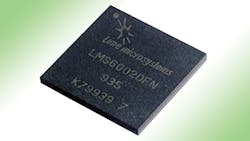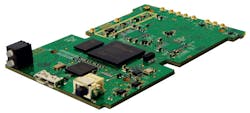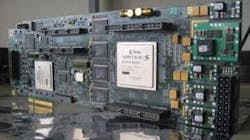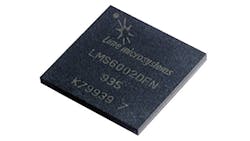Future Wireless Networks Will Rely On Programmable SDRs
The past decade has seen the wireless sector change almost beyond recognition.
When the first 3G cellular networks launched in early 2003, equipment makers understood which frequency bands they needed to support in each region.
This file type includes high resolution graphics and schematics when applicable.
However, the rise of new systems such as 4G networks, software defined radios (SDRs), machine-to-machine (M2M) communications, and open-source radios means that manufacturers of wireless communication systems have to design and launch products into an increasingly uncertain environment, and flexibility is now essential.
4G Networks
Apple’s third-generation iPad highlighted the need for flexibility. It was launched last year to great fanfare with many users excited about being able to access 4G networks and, with them, download speeds of 100 Mbits/s. However, the only LTE bands the product’s transceivers accessed were 700 MHz and 2.1 GHz.
Related Articles
- Software-Defined Radios Are Here Now
- SDR Architecture Promises Smaller Interoperable Military Radios
- SDR And CR Boost Wireless Communications
At the time, these bands were only used in the U.S., which left potential users in the rest of the world out in the cold. InAustralia, which uses the 1.8-GHz band, Apple was forced to offer refunds because it advertised the devices’ 4G connectivity. And a survey of those queuing outside the London Apple store on the 2012 launch, undertaken by the analyst group Informa, noted that 12% were queuing to get LTE connectivity even though there were no 4G networks in the U.K. at the time.1
Indeed, according to Strategy Analytics analyst Chris Taylor, more than 40 LTE (E-UTRA to be more precise) bands exist globally, with over 35 assigned and a few pending approval.2
This is not just restricted to handsets. Small-cell (also known as femtocell and metrocell) basestations mounted on light posts and other street furniture will play a pivotal role in enabling operators to roll out the networks in line with user numbers.
Cisco currently predictsthat 1.4 zettabytes (1021 bytes) will flow over global networks by 2017. North America alone will generate 1.3 exabytes (1018 bytes) of Internet protocol (IP) traffic per day. Small cells will be placed where the traffic demands are highest, and they will be essential in enabling the mobile networks to grow.
As a result of this rise in mobile data, LTE operators anticipate that more than half of their annual capital expenditures will be allocated to meet this demand for smaller cells. The prediction is a market size of $2.7 billion by 2017, with London’s lampposts spawning no fewer than 72,000 small cells. Operators are, understandably, stipulating that the cost of rolling out small cells must be kept low, and this is a real challenge for manufacturers.
For small-cell manufacturers, the problem of servicing multiple frequency bands for each protocol is exacerbated by the drive for inventory efficiency. One way to manage the complexity of dealing with more than 40 LTE frequency bands is to make different products for each region.
Tuning a femtocell or handset for a particular market, though, increases overall inventory levels. Worse still, inventory that has been built up and personalized for one region cannot be shipped to fulfil a shortfall of product for another region.
Although early adopters of LTE have built market-specific variants to access different regions, they see the need to move to a single, global design. This streamlining of production and reduction in product mix will reduce the drag on profitability from excess work in progress (WIP) and finished inventory.
SDR And The Internet of Things
What is happening in small cells is being reflected in an increasing range of radio systems. Within a few years, the market for the Internet of Things (IoT) is forecast to see explosive growth as applications such as the Smart Grid and intelligent industrial and home automation systems take hold.
One major component of the IoT will be the smart gateway that acts as the coordination point between low-power, low-cost local sensor nodes and the wider Internet. These gateways will need to support a wide range of protocols and interfaces, though not necessarily simultaneously. The problem is that both the network and transmission use multiple standards that will take time to harmonize.
On the gateway side, each standard such as Bluetooth, Wi-Fi, and ZigBee offers distinctive advantages, such as low-power communications, security, or greater bandwidth for sensor reading, video recording, and other applications. They can also span a range of frequency bands that include unlicensed spectrum in the sub-gigahertz range, as well as the increasingly congested 2.4-GHz industrial, scientific, and medical (ISM) band.
Wide-area networks (WANs) support numerous choices, including the cellular standards and high-bandwidth backhaul protocols. In addition, emerging unlicensed standards such as Weightless and other white-space or cognitive-radio systems can take advantage of new tranches of spectrum that various governments are beginning to open up. Once again, the available frequency bands differ between countries, and equipment vendors need a flexible solution to maximize their economies of scale.
Alternative SDR Applications
Beyond the IoT, one of the neatest flexible radio applications that we’ve seen recently comes from navigation specialists Loctronix. Its ASR-2300 SDR module with multiple-input multiple-output (MIMO) combines field-programmable RF (FPRF) transceiver technology with inertial sensors and can undertake position detection within large buildings and urban canyons (Fig. 1).
The ASR-2300 was shown for the first time in September at the United States Institute of Navigation’s annual meeting in Nashville, Tenn. A flexible radio, it can be optimized for any market using the mobile networks to triangulate a position.
Cognitive Radio
Cognitive radio is an exciting concept, but it adds a new dimension of complexity to radio design since it demands transmitters and receivers that are agile enough to switch between frequency bands on demand. This approach to RF design is the result of the recognition that much of the RF spectrum is only rarely used but the owners or licensed holders of those frequencies want to be able to access those resources when required. If transceivers can be made more agile so they can swap to alternative bands on the fly, more of this spectrum can be brought into use without denying service to the owner or primary licence holder.
To use cognitive-radio spectrum, a transmitting node finds a free channel and communicates the frequency and modulation details to the receiver so they can communicate. As a result, cognitive-radio systems need to be RF-aware so they can analyze the radio environment that surrounds them.
One method for finding unoccupied channels is to scan through a list of channels earmarked for cognitive radio and to sample the RF power density. Those with no activity are safe to use. This technique demands an agile, programmable receiver that can scan a set of channels scattered over a wide frequency range in a controlled manner. The transmitter needs to be equally flexible to use channels as they become available.
Even small cells need to be able to perform functions that resemble some aspects of cognitive radio. Small cells are designed to fit seamlessly into the existing cellular infrastructure but do so without the extensive commissioning performed by expert engineers on macrocell or microcell basestations.
As it boots up, a small cell needs to be able to “sniff” the cellular signals around it and then configure itself accordingly. This ability will become more crucial as 4G networks demand close interoperability between small cells and other basestations so a single handset can access more than one basestation at a time without the two interfering with each other.
The Move To Flexible Architectures
Equipment vendors, operators, and even governments are now widely recognizing the need for flexibility in radio systems. Indeed, the European Union’s roadmap for SDR and cognitive radio (also known as the Acropolis Project) highlights the need for flexibility and cites Eurecomm’s Express Mimo-2 baseband platform (Fig. 2) as an example of best practice.3 This board runs four FPRF chips coupled with an FPGA, putting flexibility at its heart.
The combination of FPRF and SDR techniques provides the means to create more flexible, intelligent, and cognitive RF systems. It creates an architecture that allows the ability to support many different RF interfaces on the same core components and switch between them with ease. The architecture is a radical departure from conventional radio-system design.
A generalized model of the receiver within a radio system employs a front-end unit that extracts channels of interest from a selective band within the radio spectrum. It then down-converts these high-frequency signals to baseband so they can be processed by a modem subsystem that carries out demodulation and decoding.
The modem subsystem passes the resulting signal, usually in the form of a digital bit stream, to a network-layer processing subsystem. Transmission reverses this process. The modem receives a digital bit stream bearing data and creates a modulated signal that is passed to the RF subsystem for transmission over the wireless channel.
The problem for traditional hardware radios is that each of these functions demands the use of fixed-function hardware, using various ASICs and discrete RF and analog components to support each target air-interface standard. Although the interface-specific components allow some flexibility, such as the choice of a narrow range of channels through software control, this flexibility is limited to specific RF interfaces.
Circuitry designed for classical radio processing tends to reinforce the fixed architecture. For example, the down-conversion to baseband will often use heterodyne techniques that, traditionally, have been highly cost-effective to implement but require the devices to be tuned to specific frequency ranges.
A programmable or SDR subsystem uses software or configurable hardware to implement the bulk of functions, using digital processing as close as possible to the antenna. In this architecture, a direct or zero-intermediate frequency (zero-IF) technique replaces the cumbersome two-stage heterodyne processing that relies on conversion to intermediate frequencies before final translation to baseband.
In the baseband stage, DSP algorithms running on specialised processors or FPGAs are commonly used. These devices provide the horsepower to demodulate and decode the incoming signal from the receiver or apply the complex modulations needed for today’s protocols ready for transmission through the programmable RF subsystem.
How Flexible Is Flexible?
The first FPRF devices were demonstrated in late 2007 and early 2008. Second-generation FPRF chips are becoming available from a growing number of suppliers.
Over time, the flexibility that the FPRF class of chip offers has increased significantly. The current record for FPRF frequency flexibilityis 0.3 to 3.8 GHz. But the ability to cope with multiple standards is also an essential functionality of FPRF chips. For example, the Lime LMS6002D will run on FDD-LTE, TDD-LTE, W-CDMA, CDMA-2000, HSDPA+, and WiMAX (Fig. 3).
Summary
The wireless design market has changed dramatically in the past decade, and it now addresses an exceptionally diverse array of applications. This is especially true with the rise of SDR and M2M communications, which provide the backbone of the IoT.
The increasing complexity and intelligence in wireless environments will put greater cost pressures on discrete front-end technologies, as more users embrace programmability. The FPRF architecture offers a solution that can react to today’s challenges and tomorrow’s as well.
References
1. “Apple’s Latest iPad Highlights Major LTE Issue,” Philippe Roux, Mobile Dev & Design, http://mobiledevdesign.com/learning-resources/apple-s-latest-ipad-highlights-major-lte-issue
2. “Are Lessons From 3G Deployment Being Applied To LTE?” Ebrahim Bushehri, Electronic Design, http://electronicdesign.com/4g/are-lessons-3g-deployment-being-applied-lte
3. “Advanced coexistence technologies for radio optimisation in licensed and unlicensed spectrum,” European Union report, http://ec.europa.eu/information_society/apps/projects/logos/6/257626/080/deliverables/001_ACROPOLISD71.pdf
About the Author
Ebrahim Bushehri
Founder and CEO
Ebrahim Bushehri is the founder and CEO of the field-programmable RF chip start-up Lime Micro. He is also the founder of the non-profit initiative Myriad RF foundation, which seeks to bring open-source RF hardware to a wider audience through the development of low-cost, professional-grade hardware and free design files made available under the creative commons license.





